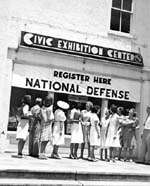Page 2
Keep the Home Fires Burning Florida's World War II Experience

Dr. David J. Coles
Thousands of Floridians volunteered or were drafted into the military, many long before the outbreak of the war. In September 1940 a number of Florida National Guard units were mobilized into Federal service, followed by the remainder in March 1941. Initially called into service for one year, these citizen-soldiers ultimately remained on active duty until 1945. Beginning with the first peacetime draft in American history in 1940, thousands of other Floridians began the transformation from civilian to soldier or sailor. Following the formal entry of the United States into the war in December 1941, many more men and women volunteered or were drafted into service. Floridians served in all major theaters of the war, and thousands paid the ultimate sacrifice. By war's end 3,540 soldiers from Florida had died, while naval casualties (killed and wounded) numbered 2,308.
Several Florida veterans deserve particular notice. Colin Kelly of Madison was one of the war's earliest heroes, receiving a Distinguished Service Cross for his actions as a bomber pilot in the Philippines. Sergeant Ernest "Boots" Thomas of Monticello led a Marine patrol that placed the first American flag atop Mount Suribachi on Iwo Jima. Alexander Nininger of Ft. Lauderdale received a Medal of Honor for leading a counterattack against the Japanese on Bataan peninsula.
 Like Kelly and Thomas, Nininger would not survive the war. Commander David McCampbell, who grew up in West Palm Beach, earned a Medal of Honor and other awards as one of the Navy's highest aces in the war. Mr. and Mrs. Robert Cockman of Groveland sent eight sons into the armed forces, perhaps the largest number of any Florida family. At least one, Tommy, was killed during the war.
Like Kelly and Thomas, Nininger would not survive the war. Commander David McCampbell, who grew up in West Palm Beach, earned a Medal of Honor and other awards as one of the Navy's highest aces in the war. Mr. and Mrs. Robert Cockman of Groveland sent eight sons into the armed forces, perhaps the largest number of any Florida family. At least one, Tommy, was killed during the war.
Although tens of thousands of Floridians served in the armed forces, the majority of the population fought the battle of the homefront. In his address to the state legislature in 1943, Florida Governor Spessard L. Holland stated:
“At this tense hour it is wholly unnecessary to remind you of the fact that we meet at the time of gravest crisis in the life of our Nation. We are engaged in a war which is challenging our deepest patriotic convictions, and demanding the most effective and sacrificial service can render, as individual citizens and as a member of the family of states.”
Virtually without exception, Floridians heeded the governor's call. By 1943, more than 300,000 had volunteered for civilian defense activities, with many more serving in the Red Cross, the U.S.O., on draft and rationing boards, and in many similar agencies. To help finance the war, Floridians had also purchased more than $145,000,000 in war bonds and stamps by 1943.
United behind the war effort as perhaps never before, Floridians joined in both voluntary and mandatory efforts to conserve strategic war materials. Drives to preserve rubber, scrap metals, rags, paper and grease became popular, as did "victory gardens" and "meatless" days to stretch the nation's food resources.
Shortages and rationing of various goods also became commonplace during the war. Rationing Boards were established in every county with the power to regulate the sale of 90% of all civilian goods. Every man, woman and child in the state received a ration book limiting what could be purchased. One historian has written that:
As the war drew on, nearly every item Americans ate, wore, used or lived in was rationed or otherwise regulated. It was the most concerted attack on wartime inflation and scarcity in the nation's history and by and large it worked.(2).


